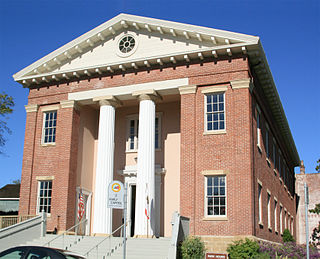
Benicia is a city in Solano County, California, located on the north bank of the Carquinez Strait in the North Bay region of the San Francisco Bay Area. It served as the capital of California for nearly thirteen months from 1853 to 1854. The population was 27,131 at the 2020 United States Census. Benicia is just east of Vallejo and across the strait from Martinez.
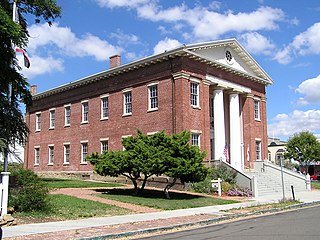
Benicia Capitol State Historic Park is a state park in Benicia, California, United States. The park is dedicated to California's third capitol building, where the California State Legislature convened from February 3, 1853, to February 24, 1854, when they voted to move the state capital to Sacramento. It is the only pre-Sacramento capitol that remains. The park includes the Fischer-Hanlon House, an early Benicia building that was moved to the property and converted into a home in 1858, after the legislature departed. Benicia Capitol State Historic Park just off the city's main street also includes a carriage house, workers' quarters and sculptured gardens.
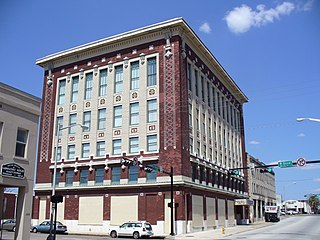
The Masonic Temple is a historic Masonic temple in Jacksonville, Florida. It is located at 410 Broad Street. Constructed by the Grand Lodge between 1901 and 1912, it was added to the U.S. National Register of Historic Places on September 22, 1980.

The Masonic Hall of Hiram Masonic Lodge No. 7 is a historic Gothic revival building on South 2nd Avenue in Franklin, Tennessee. Constructed in 1823, it is the oldest public building in Franklin. It is nationally significant as the site of negotiations leading to the Treaty of Franklin, the first Indian removal treaty agreed after passage of the 1830 Indian Removal Act. It was declared a National Historic Landmark in 1973. It continues to serve the local Masonic lodge.

The Highland Park Masonic Temple, also known as The Mason Building or The Highlands, is a historic three-story brick building on Figueroa Street in the Highland Park district of northeast Los Angeles, California.
A Masonic Hall is the room or edifice where a Masonic Lodge meets.
A Mississippi Landmark is a building officially nominated by the Mississippi Department of Archives and History and approved by each county's chancery clerk. The Mississippi Landmark designation is the highest form of recognition bestowed on properties by the state of Mississippi, and designated properties are protected from changes that may alter the property's historic character. Currently there are 890 designated landmarks in the state. Mississippi Landmarks are spread out between eighty-one of Mississippi's eighty-two counties; only Issaquena County has no such landmarks.

The Masonic Temple is a historic Masonic building in Philadelphia. Located at 1 North Broad Street, directly across from Philadelphia City Hall, it serves as the headquarters of the Grand Lodge of Pennsylvania, Free and Accepted Masons. The Temple features the Masonic Library and Museum of Pennsylvania, and receives thousands of visitors every year to view the ornate structure, which includes seven lodge rooms, where today a number of Philadelphia lodges and the Grand Lodge conduct their meetings.

The former Masonic Temple is a historic commercial and social building at Main and High Streets in downtown Belfast, Maine. Built in 1877, it is one of the city's most elaborately decorated buildings, featuring Masonic symbols. It was listed on the National Register of Historic Places in 1973. While there are active Masonic organizations in Belfast, they now meet in a modern facility on Wight Street.

Masons' Hall, located in the Shockoe Bottom neighborhood of Richmond, Virginia was built during 1785 to 1787 by Richmond Lodge No. 13. The building is still the active home of and owned by Richmond Randolph Lodge No.19 who have met in their third floor lodge room continuously since Masons’ Hall was completed in 1787. It was listed on the U.S. National Register of Historic Places in 1973.

The Crane Hill Masonic Lodge is a historical Masonic building in Crane Hill, Alabama, United States. Built in 1904, it is listed on the National Register of Historic Places.
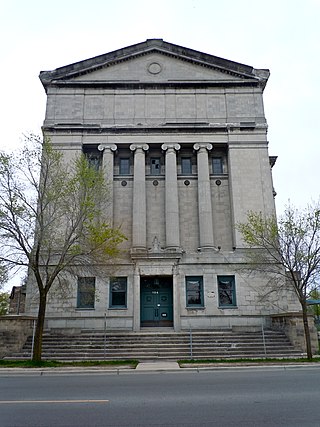
The Masonic Temple in Aurora, Illinois was a historical building where Freemasons held meetings. Opened in 1924, it was added to the National Register of Historic Places in 1982. On October 7, 2019 it was gutted by fire, leading to its subsequent demolition.

The Kilbourn Masonic Temple is a historic Masonic building located in Milwaukee, Wisconsin. It was constructed in 1911 as a meeting hall for Kilbourn Lodge #3, a local Masonic lodge which was one of the first three organized in Wisconsin in 1843. The Masons no longer meet in the building). It was listed on the National Register of Historic Places in 1986. When it celebrated its 100th anniversary in 2011, the temple was automatically deemed a landmark in the city of Milwaukee. The temple used to serve as a fraternity house for the Kappa Sigma chapter at Marquette University but is now rented as living space for residents/students.
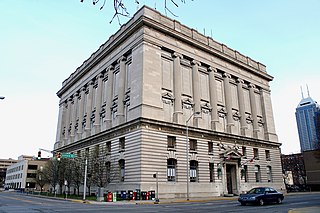
The current Indianapolis Masonic Temple, also known as Indiana Freemasons Hall, is a historic Masonic Temple located at Indianapolis, Indiana. Construction was begun in 1908, and the building was dedicated in May 1909. It is an eight-story, Classical Revival style cubic form building faced in Indiana limestone. The building features rows of engaged Ionic order columns. It was jointly financed by the Indianapolis Masonic Temple Association and the Grand Lodge of Free and Accepted Masons of Indiana, and was designed by the distinguished Indianapolis architectural firm of Rubush and Hunter.

The Brewster Building is a historic commercial building and IOOF Hall located at 201 Fourth Street in Galt, California. It was built in 1882 and was listed on the National Register of Historic Places in 2000.
Old Masonic Lodge may refer to:

The Carr House is a now demolished historic building in Benicia, California, United States. It was added to the U.S. National Register of Historic Places on September 13, 1979.
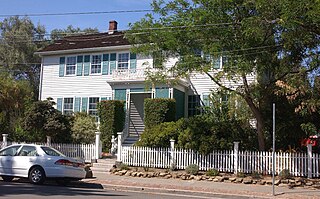
Fischer-Hanlon House is historical house built in 1858 in Benicia, California in Solano County, California. The Fischer-Hanlon House is California Historical Landmark No. 880, listed on March 14, 1975. The Fischer-Hanlon House was built by Joseph Fisher in 1849. Fisher, a butcher, was a Swiss immigrant who came to Benicia and purchased a plot of land on July 1, 1858. He then purchased a nearby old hotel and had it moved to his lot. The California Gold Rush home is built in an East Coast Federalist architectural style. The wooden house has fourteen rooms. It was damaged in a fire in 1856. After Joseph and Catherine Fischer moved in they repaired and remodeled the home. The Fischer house was passed down to later generations, then was donated to the State of California in 1969 by Fischer's granddaughters, Raphaelita and Catherine Hanlon, in memory of their sister Marie Rose. The Fischer-Hanlon House is restored and is furnished in 1880s decor. The outside is a Victorian Garden.



















